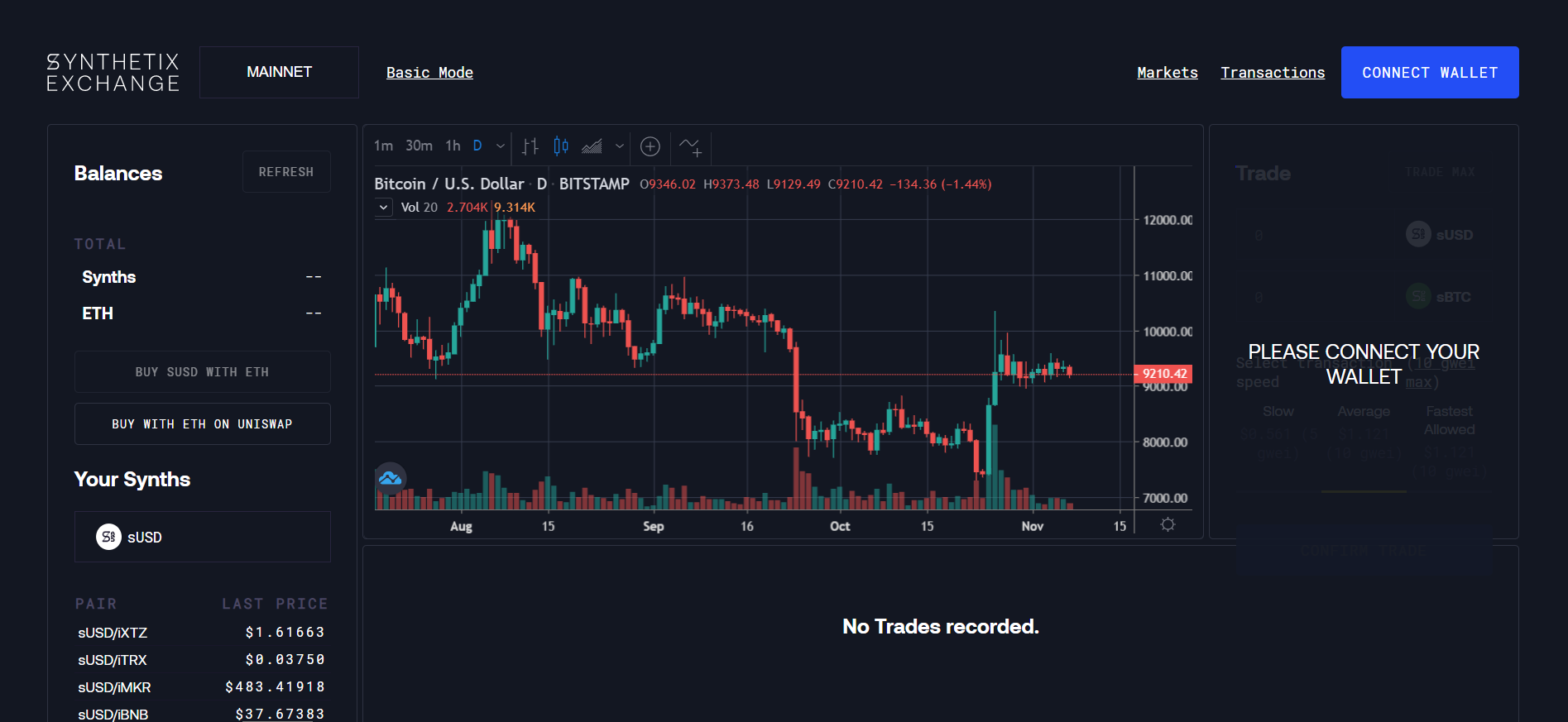
Synthetix Exchange

Comisiones de intercambio
Métodos de depósito
Criptomonedas compatibles (0)
Synthetix Exchange Review
What is Synthetix Exchange?
Synthetix Exchange is a decentralized exchange (DEX) that launched in 2018. The team working on the exchange is based in Australia.
Trading Volume
If you look at the trading volume of this particular platform, it is quite OK. Although we don’t have any data from coinmarketcap.com to rely on, CoinGecko reports that the 24 hour trading volume on the date of first writing this review (7 November 2019) was USD 8.67 million. On the date of last updating this review though (16 March 2020, right in the middle of the crisis with COVID-19), the 24 hour trading volume was only USD 155,668. This is quite low and it must definitely improve in order for this exchange to be a viable option for someone trading crypto.
US-investors
As this is a DEX, it is also open to citizens or residents from the United States. Or rather, the citizenship or residency is of less importance for DEXs seeing as they never hold their users’ assets.
General information on DEXs
DEXs are becoming increasingly more popular, mostly due to the following factors:
- They do not require a third party to store your funds, instead, you are always directly in control of your coins and you conduct transactions directly with whoever wants to buy or sell your coins.
- They normally do not require you to give out personal info. This makes it possible to create an account and right away be able to start trading.
- Their servers spread out across the globe leading to a lower risk of server downtime.
- They are essentially immune to hacker attacks.
However, DEXs normally have an order book with lower liquidity than their centralized counterparts.
Synthetix Exchange Trading View
Different exchanges have different trading views. And there is no “this overview is the best”-view. You should yourself determine which trading view that suits you the best. What the views normally have in common is that they all show the order book or at least part of the order book, a price chart of the chosen cryptocurrency and order history. They normally also have buy and sell-boxes. Before you choose an exchange, try to have a look at the trading view so that you can ascertain that it feels right to you. The below is a picture of the trading view at Synthetix Exchange (obviously without any wallet connected):

Synthetix Exchange Fees
Synthetix Exchange Trading fees
The one thing we can’t stress enough is that you must always ascertain the trading fees at any exchange you are interested in. Every trade occurs between two parties: the maker, whose order exists on the order book prior to the trade, and the taker, who places the order that matches (or “takes”) the maker’s order. Makers make the liquidity in a market and takers remove this liquidity by matching makers’ orders with their own.
The global industry average taker fee has for a long time been 0.25% of the value of the order. Today, we see a shift towards even lower industry averages. Many new exchanges now charge 0.15% or 0.10% instead.
At Synthetix Exchange, both takers and makers pay 0.30%. This fee is slightly above the historic industry average, but quite a bit above the newer industry averages.
Synthetix Exchange Withdrawal fees
Another fee to consider before choosing which exchange to trade at is the withdrawal fee. The withdrawal fee is usually fixed (regardless of the amount of cryptocurrency units withdrawn), and varies from cryptocurrency to cryptocurrency. The global industry average withdrawal fee is 0.000812 BTC when you withdraw BTC.
Here, at Synthetix Exchange, you don’t really make withdrawals (all trading is wallet to wallet) so there’s not really a withdrawal fee to compare with in the first place.
Deposit Methods
Synthetix Exchange does not – like all (or at least close to all) other DEXs – accept any deposits of fiat currency. This means that crypto investors without any previous holding of crypto assets can’t trade at this trading platform. In order to purchase your first cryptos, you need a so called entry-level exchange, which is an exchange accepting deposits of fiat currency. Find one by using our Exchange Finder!
Synthetix Exchange Security
The servers of DEXs normally spread out across the globe. This is different from centralized exchanges that normally have their servers more concentrated. This spread-out of servers leads to a lower risk of server downtime and also means that DEXs are virtually immune to attacks. This is because if you take out one of the servers, it makes little to no difference for the network of servers in its entirety. However, if you manage to get into a server at a centralized exchange, you can do a lot more harm.
Also, if you make a trade at a DEX, the exchange itself never touches your assets. Accordingly, even if a hacker would somehow be able to hack the exchange (in spite of the above), the hacker can not access your assets. If you make a trade at a centralized exchange, however, you normally hold assets at that exchange. That is, until you withdraw them to your private wallet. A centralized exchange can therefore be hacked and your funds held at such exchange can be stolen. This is not the case with respect to decentralized exchanges.